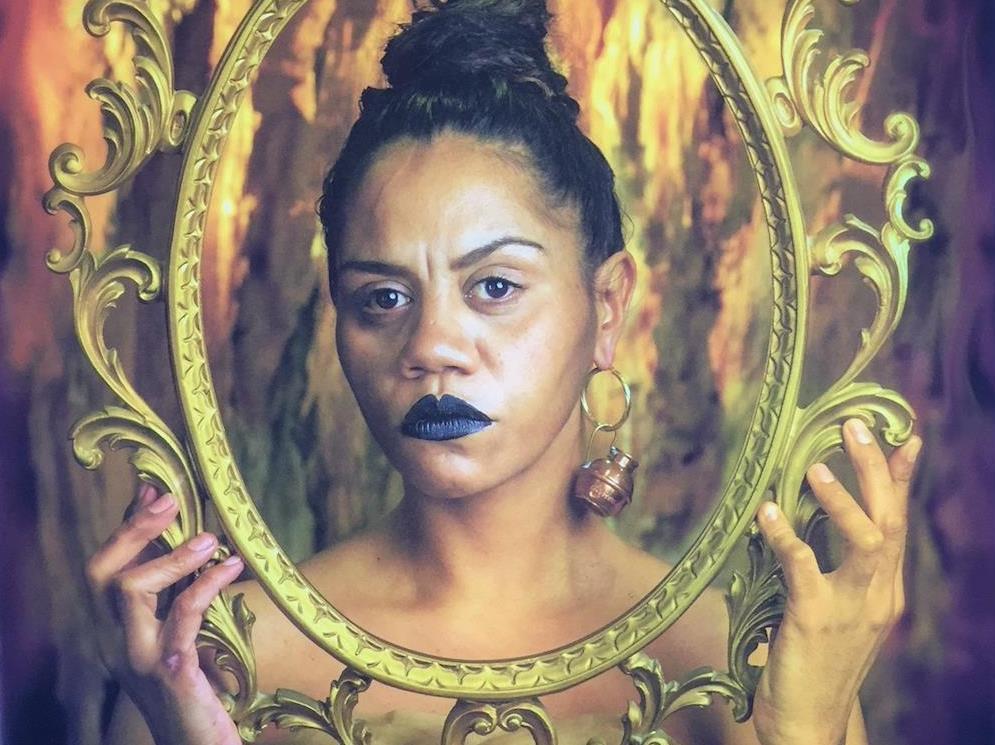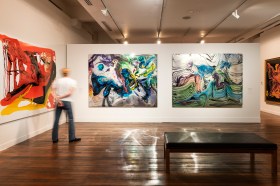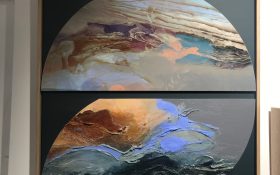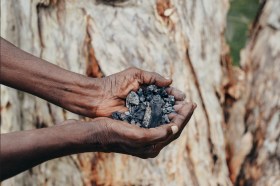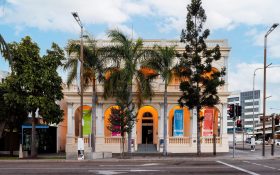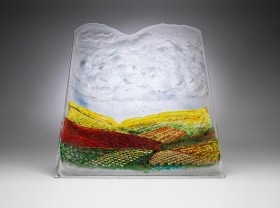Detail of Ali Gumillya Baker’s SovereignGODDESSnotdomestic #2; courtesy the artist
Walking into Adelaide’s independent art space ACE Open this month, the gallery walls are painted black. It feels slick and elegant; it also feels powerful and symbolic. But there is another emotion that hits you. The group of artworks presented jump off the walls with an almighty wallop and shout, “Hey you, take note”.
Next Matriarch is an exhibition of seven First Nations women who represent the next wave of sovereign female voices in Australian contemporary art, explain co-curators, Yorta Yorta woman Kimberley Moulton and Liz Nowell, Director of ACE Open.
Nowell, who as a non-Indigenous woman admitted she felt reserved in curating a show of Aboriginal artists, said that that it was vital to throw light on this political space – a space Moulton has been looking at for some time as the Senior Curator, South Eastern Australia Aboriginal Collections at Melbourne Museum.
‘This exhibition is both an ode to sisterhood, those who have come before, and a message for the future female,’ Moulton said.
Looking at the work, deeply edged with an activist tone, the message of resilience and solidarity is crystal clear.
Presented as part of Tarnanthi: Festival of Contemporary Aboriginal & Torres Strait Islander Art, Next Matriarch pulls together artists who are stylistically diverse, scattered in terms of Country, and at very different points in their career.
It sounds like something that could go wrong very easily. But Moulton and Nowell draw out a synergy across this exhibition through that very complex history of what it is to be a sovereign woman making art in our times.
The artists shown are Hannah Brontë, Amrita Hepi, Kaylene Whiskey, Ali Gumillya Baker, Paola Balla, Miriam Charlie and Nicole Monks.
Listening to the co-curators speak with the artists in a panel discussion for Tarnanthi’s opening weekend, the bond between these women is palpable. But does that make for a good show?
Layers of history in floating images of her ancestors over matriarchal Country is Paola Balla’s installation Lovescapes: Wemba-Wemba Country (2017); installation view ACE Open, courtesy the artist
Does a personal connection heighten the experience?
The first works the viewer encounters are Nicole Monks’ video work mother (2017), a three channel video that taps into the fears and emotions of motherhood, and adjacent to it, one of Baker’s photographic lightbox works honouring Nunga women who worked as unpaid domestics. Straight up we’re asked: what is it to nurture?
Most of the artists in this exhibition draw on photomedia as a foundation to their making. ‘Photography is really important to us,’ Baker said. ‘We have lost so many of our family that the images of people are very important.’
Nowell explained that Baker has used jewellery in her portraits, worn as a metaphor. ‘It’s this annoying thing on you, like an earring, but it’s part of you.’
In SovereignGODDESSnotdomestic #2 (pictured top) Baker’s portrait is turned slightly, like the Mona Lisa‘s stance; deflected but engaged and exposing the miniature pots and pans that hang from the sitter’s ear. It feels traditional in genre and yet, with her dark painted lips she is the picture of a warrior, defiant and proud.
Raised in a political family, Baker has stressed the importance of speaking out. For her, ‘speaking is also about survival’. It is almost like a battle cry for this exhibition. These artists have not been heard for too long, and yet have carried the stories of their mothers and grandmothers for generations.
Baker’s Nana Ruby and Nana May both worked as domestics, one for 40 years for a policeman without pay and the other from the age of six. She said: ‘We are giants of our histories. Colonialism is the shallowness at the end of eons of lawfulness.’
It is an interesting provocation when considered with Hannah Brontë’s rap video that takes on the persona of Mother Nature. The piece dominates the main gallery with its soundtrack seemingly bleeding into our very consciousness. She writes of her work: ‘The video visualizes the environmental destruction in relation to the female black body. What would Mother Earth say looking at how mistreated she has been for thousands of years?’
It is an angry work; it is abrasive and persistent, her voice ‘slicing through the polluted air’, as Brontë describes it, and yet it is about reclaiming that space.
Video still: Hannah Brontë’s Umma’s Tongue-molten at 6000 (2017); courtesy the artist
Again taking a political voice, but with a much softer approach, is Amrita Hepi with her video installation, Dance Rites (2017). She uses the body as a springboard for the ultimate archive, and attempts to unpack how descriptions are imposed upon the female body.
Hepi explaines: ‘Dance Rites probes what it means to prove cultural authenticity through the lens of a dance floor or performative space … This work asks what is learned and what is embodied, what is permitted and what social inscriptions are imposed on the black and brown female body.’
She layers everything from protest movements and the gestures of sport heroes like Cathy Freeman to pop stars, in a kind of ethnographic veneer.
Installation view: Amrita Hepi’s video Dance Rites (2017) ACE Open, courtesy the artist
Completing the exhibition are great works by Anangu painter Kaylene Whiskey, from Iwantja Arts at Indulkana in the APY Lands, and Paola Balla’s piece exploring matriarchal lineage and its role in story telling – both artists very much connecting with law and Country.
Whiskey creates her own comic book style narratives usurping the roles of popular female superheroes like Wonder Woman and Tripitaka from Monkey Magic, as well as music icons such as Tina Turner, Cher and Dolly Parton. In them she celebrates the power, street smarts and traditional knowledge of strong women in remote communities and places them on equal ground with these global heroines of contemporary culture.
They have great humour and great desert knowledge, and Whiskey shows how traditional law can have contemporary traction.
Kaylene Whiskey, Strong Kungka Story 1, 2017; courtesy the artist and Iwantja Arts
Balla’s installation Lovescapes: Wemba-Wemba Country (2017) overlays images of her great-great-grandmother through to her daughter upon her ancestral ‘women’s place on the creek’, where six generations of women have met, nurtured, learnt, and survived.
She says: ‘This matriarchy is older than white feminism and teaches me of women’s authority, knowledge and ways of being. We are matriarchal warriors … As women, as artists, protectors, activists and story tellers, we disrupt the white spaces where we are erased and rendered invisible despite being at the forefront of fighting for rights, Country and family.’
Through this work Balla hopes that she can present a message that First Nations women can heal from grief and trauma.
It is easy to agree with Moulton and Nowell that this work needs to be more visible. Often Blak Matriarchal stories are overshadowed in contemporary Aboriginal art – a space that could be argued as male dominated.
While the work is very disparate, which can make for an uneven show, it can be thought of more like a mini-survey that slices across a zeitgeist rather than as a nuanced curatorial position, just like the snapshot exhibition Primavera at the MCA. And with that in mind, the thought then is that this exhibition should continue on a regular basis.
Rating 4 out of 5
Next Matriarch
ACE Open
Lion Arts Centre, North Terrace, Adelaide
15 October – 9 December 2017
